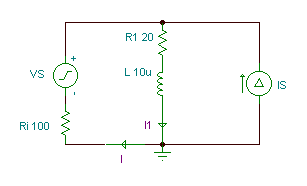Superposition theorem is one of those strokes of genius that takes a complex
subject and simplifies it in a way that makes perfect sense. A theorem like
Millman's certainly works well, but it is not quite obvious why it works
so well. Superposition, on the other hand, is obvious.
The strategy used in the Superposition Theorem is to eliminate all but one
source of power within a network at a time, using series/parallel analysis to
determine voltage drops (and/or currents) within the modified network for each
power source separately. Then, once voltage drops and/or currents have been
determined for each power source working separately, the values are all
“superimposed” on top of each other (added algebraically) to find the actual
voltage drops/currents with all sources active.
Steps
in Superposition Theorem
- Turn off all independent sources except one source. Find the output (voltage or current) due to that active source using nodal or mesh analysis.
- Repeat step 1 for each of the other independent sources.
- Find the total contribution by adding algebraically all the contributions due to the independent sources
To
calculate the contribution of each source independently, all the other sources
must be removed and replaced without affecting the final result.
When
removing a voltage source, its voltage must be set to zero, which is equivalent
to replacing the voltage source with a short circuit.
When
removing a current source, its current must be set to zero, which is equivalent
to replacing the current source with an open circuit.
Now let's explore an example.
In the circuit shown below,
C = 0.3 nF, vS(t)=50cos(wt) V, iS(t)=1cos(wt+30°) A,
f=400 kHz.
First substitute an open circuit
for the current source and calculate the complex phasors I', I1' due to the contribution only from VS.
The currents in this case are
equal:
I' = I1'
= VS/(Ri + R1 + j*w*L)
= 50/(120+j2*p*4*105*10-5)
= 0.3992-j0.0836
I' =
0.408 ej 11.83°
A
Next
substitute a short-circuit for the voltage source and calculate the complex
phasors I'', I1'' due to the
contribution only from IS.
In this case we can use the
current division formula:
I'' = -0.091 - j 0.246 A
and
I1" =
0.7749 + j 0.2545 A
The sum of the two steps:
I
=
I' + I" = 0.3082 - j 0.3286 = 0.451 e- j
46.9°
A
I1
= I1" + I1'
= 1.174 + j 0.1709 = 1.1865 ej 8.28°
A
The time functions of the
currents:
i(t)
= 0.451 cos (w×t
- 46.9°)
A
i1(t)
= 1.1865 cos (w×t
+ 8.3°)
A





No comments:
Post a Comment